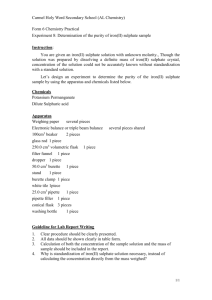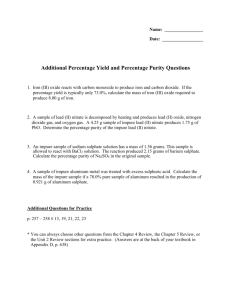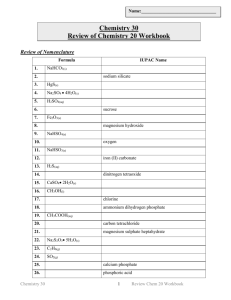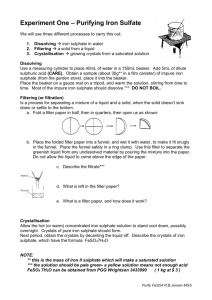3. Observing chemical changes
advertisement
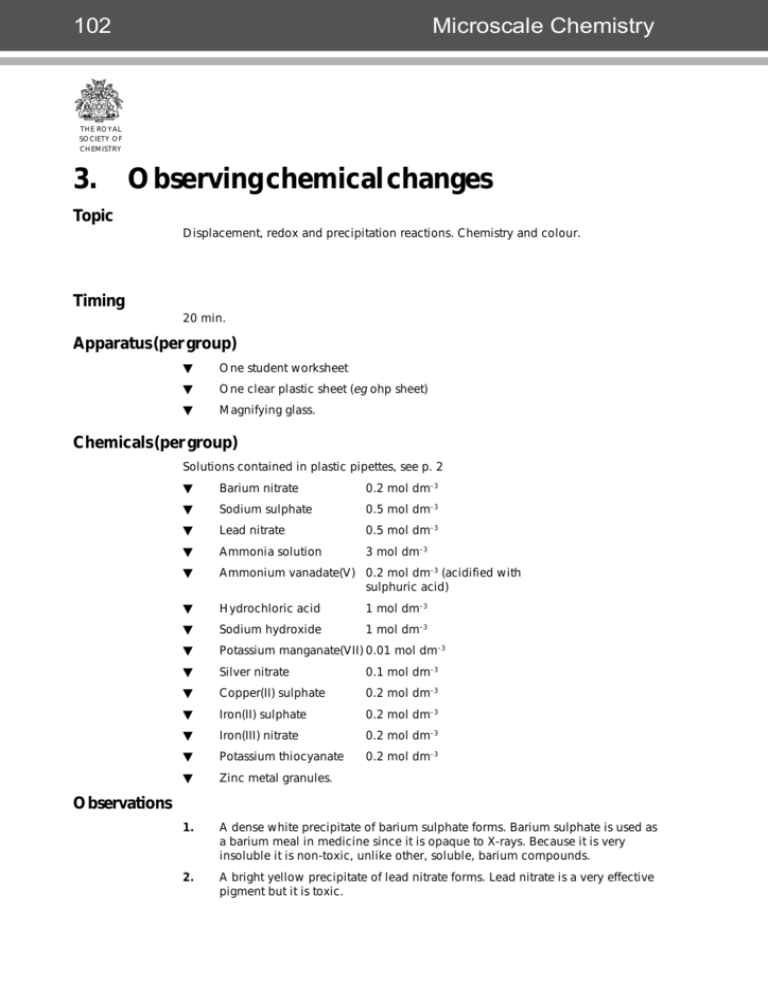
102 Microscale Chemistry THE ROYAL SOCIETY OF CHEMISTRY 3. Observing chemical changes Topic Displacement, redox and precipitation reactions. Chemistry and colour. Level Any. Timing 20 min. Apparatus (per group) ▼ One student worksheet ▼ One clear plastic sheet (eg ohp sheet) ▼ Magnifying glass. Chemicals (per group) Solutions contained in plastic pipettes, see p. 2 ▼ Barium nitrate 0.2 mol dm–3 ▼ Sodium sulphate 0.5 mol dm–3 ▼ Lead nitrate 0.5 mol dm–3 ▼ Ammonia solution 3 mol dm–3 ▼ Ammonium vanadate(V) 0.2 mol dm–3 (acidified with sulphuric acid) ▼ Hydrochloric acid 1 mol dm–3 ▼ Sodium hydroxide 1 mol dm–3 ▼ Potassium manganate(VII) 0.01 mol dm–3 ▼ Silver nitrate 0.1 mol dm–3 ▼ Copper(II) sulphate 0.2 mol dm–3 ▼ Iron(II) sulphate 0.2 mol dm–3 ▼ Iron(III) nitrate 0.2 mol dm–3 ▼ Potassium thiocyanate 0.2 mol dm–3 ▼ Zinc metal granules. 1. A dense white precipitate of barium sulphate forms. Barium sulphate is used as a barium meal in medicine since it is opaque to X-rays. Because it is very insoluble it is non-toxic, unlike other, soluble, barium compounds. 2. A bright yellow precipitate of lead nitrate forms. Lead nitrate is a very effective pigment but it is toxic. Observations Microscale Chemistry 103 THE ROYAL SOCIETY OF CHEMISTRY 3. A deep red colour is produced due to iron(III) thiocyanate ions . This reaction is used to test for the presence of iron. 4. A deep blue colour of tetra-amminocopper(II) forms. There may also be some light blue precipitate of copper(II) hydroxide. 5. Bubbles (of hydrogen) are seen. The yellow colour of the ammonium vanadate gradually changes (as the vanadium is reduced) to blue owing to the formation of the vanadium(IV) ion (VO2+). The colour then changes to green due to the vanadium(III) ion (V3+) and finally to lilac due to the vanadium(II) ion (V2+). The changes in oxidation states of vanadium salts have been investigated for applications in battery technology. 6. A greenish precipitate of iron(II) hydroxide forms. This gradually changes to the brown iron(III) hydroxide as the iron is oxidised. 7. The deep purple colour of the potassium manganate(VII) gradually fades first to the brown manganese(IV) dioxide and then to the pale pink manganese(II) ion (Mn2+). Manganese(II) compounds in solution usually appear virtually colourless. However, a solid manganese(II) salt is pink. 8. Barium hydroxide forms. This is soluble so nothing is seen at first. Barium hydroxide is alkaline and gradually absorbs carbon dioxide from the air to form the insoluble barium carbonate. The drop takes on a hazy appearance as a skin of barium carbonate forms on the surface. 9. A glittering of metallic silver forms as the iron(III) reduces the silver nitrate. This is seen clearly using a magnifying glass. 10. The surfaces of the pieces of zinc turn red-brown as copper metal deposits via a displacement reaction. The blue colour of the copper(II) sulphate solution fades. Note Both procedure 9 and procedure 10 involve the displacement of a valuable, but less reactive, metal using a less valuable, but more reactive, metal. This could be used as a topic for discussion. Safety Students must wear eye protection. It is the responsibility of the teacher to carry out a risk assessment. 20 Microscale Chemistry THE ROYAL SOCIETY OF CHEMISTRY 3. Observing chemical changes In this experiment you will be observing the changes that occur when you mix solutions of chemicals on the grid shown. Instructions 1. Cover the worksheet with a clear plastic sheet. 2. Put two drops of barium nitrate solution into box 1 (at the top of the middle column). Add two drops of sodium sulphate solution to the drops of barium nitrate solution. 3. Put two drops of lead nitrate soluion into box 2. Add two drops of potassium iodide solution to the drops of lead nitrate solution. 4. Put two drops of iron(III) nitrate solution into box 3. Add one drop of potassium thiocyanate solution to the iron(III) nitrate solution. 5. Put two drops of copper(II) sulphate solution into box 4. Add two drops of ammonia solution to the copper(II) sulphate solution. 6. Put two drops of ammonium vanadate(V) solution into box 5. Add one drop of hydrochloric acid, then a small piece of zinc metal to the ammonium vanadate(V) solution. 7. Put two drops of iron(II) sulphate solution into box 6. Add two drops of sodium hydroxide solution to the iron(II) sulphate solution. 8. Put two drops of potassium manganate(VII) solution into box 7. Add two drops of iron(II) sulphate solution to the potassium manganate(VII) solution. 9. Put two drops of barium nitrate solution into box 8. Add two drops of sodium hydroxide to the barium nitrate solution. Observe, and record any changes over the next 10 min. 10. Put one drop of silver nitrate solution into box 9. Add one drop of iron(II) sulphate to the silver nitrate solution. Observe closely using a magnifying glass. 11. Put two drops of copper(II) sulphate solution into box 10. Add a small piece of zinc metal to the copper sulphate solution. Microscale Chemistry 21 THE ROYAL SOCIETY OF CHEMISTRY Barium nitrate 1 Sodium sulphate Lead nitrate 2 Potassium iodide Iron(III) nitrate 3 Potassium thiocyanate Copper(II) sulphate 4 Ammonia solution Ammonium vanadate(V) 5 Hydrochloric acid and zinc Iron(II) sulphate 6 Sodium hydroxide Potassium manganate(VII) 7 Iron(II) sulphate Barium nitrate 8 Sodium hydroxide Silver nitrate 9 Iron(II) sulphate 10 Zinc Copper(II) sulphate


